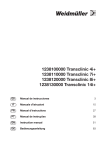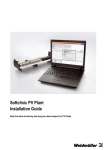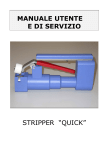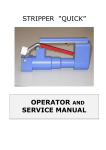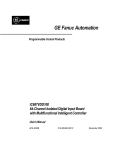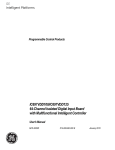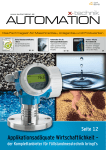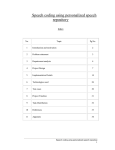Download Weidmuller SL-MOD-GW Installation guide
Transcript
Transclinic Xi+ Installation Guide PV Array Performance Monitor with Modbus Interface Revision History Contact details Version Date Version 1.0 12/2011 First release (Australian version) Weidmuller Pty Ltd 43 Huntingwood Drive Huntingwood NSW 2148 Australia Tel. +61 (0) 2 9671 9999 Fax +61 (0) 2 9671 9900 E-Mail [email protected] Internet www.weidmuller.com.au Contents Revision History ............................................................................................................................................... 2 Contact details .................................................................................................................................................. 2 Contents ............................................................................................................................. 3 1. Introduction ........................................................................................................... 5 1.1 General description........................................................................................................................... 5 1.2 Warnings and notices ....................................................................................................................... 6 1.2.1 Qualified personnel .............................................................................................................. 6 1.2.2 Accuracy of the technical documentation ............................................................................ 6 1.2.3 CE Mark ............................................................................................................................... 6 1.2.4 Declaration of Conformity .................................................................................................... 6 1.2.5 Recycling in accordance with WEEE ................................................................................... 7 What we can do for you? ................................................................................................................. 7 What do you have to do?................................................................................................................. 7 1.2.6 Use as intended ................................................................................................................... 7 2. Installation ............................................................................................................. 8 2.1 General ............................................................................................................................................... 8 2.2 Location ............................................................................................................................................. 8 2.3 Connection diagram.......................................................................................................................... 9 2.4 Power Board Connections ............................................................................................................. 10 2.4.1 PV Array wiring (X1, X2, X4 and Busbars) ........................................................................ 10 String current measurement Inputs (X1 and X4) ........................................................................... 10 String current measurement common output (Busbar) ................................................................. 10 Voltage measurement (X2)............................................................................................................ 11 2.5 3. CPU Board Connections ................................................................................................................ 11 2.5.1 Power supply (X7).............................................................................................................. 11 2.5.2 Data Communications (X1 and X3) ................................................................................... 11 2.5.3 Opto-coupled Digital inputs (X8) ........................................................................................ 12 2.5.4 Analogue Current/Voltage Inputs (X6 and X5) .................................................................. 12 2.5.5 Digital output (X4) .............................................................................................................. 12 Configuration....................................................................................................... 13 3.1.1 DIP Switches ...................................................................................................................... 13 3.1.2 SW1 – Modbus Address .................................................................................................... 13 3.1.3 SW2 – Data Speed, Parity and Read/Write Lock .............................................................. 13 PV Clinics Installation Manual 21/07/11 01.00 3 4. Surge protection ................................................................................................. 14 4.1 Best practice for PV Plants ............................................................................................................ 14 4.2 Common mode and differential voltages...................................................................................... 14 4.3 Types of surge protection devices ................................................................................................ 15 4.3.1 DC arresters for PV Array side protection ......................................................................... 15 4.3.2 AC arresters for supply side protection.............................................................................. 15 4.3.3 Surge protection for data communications equipment ......................................................15 5. Data Communications ........................................................................................ 16 5.1 General ............................................................................................................................................. 16 5.2 RS485 signals .................................................................................................................................. 16 5.2.1 Two wire RS485 ................................................................................................................. 17 5.2.2 Cable Shields ..................................................................................................................... 18 5.2.3 Mixed devices on Transclinics networks............................................................................ 18 5.2.4 Data Cables ....................................................................................................................... 19 5.2.5 Network Topography.......................................................................................................... 19 5.2.6 Termination resistances ..................................................................................................... 20 5.2.7 Addresses, network length and repeaters ......................................................................... 20 5.3 Rules for reliable RS485 networks ................................................................................................ 21 6. Modbus ................................................................................................................ 22 6.1 General ............................................................................................................................................. 22 6.2 Modbus RTU .................................................................................................................................... 22 6.3 Alternative communications methods .......................................................................................... 23 6.3.1 Modbus TCP (Ethernet) ..................................................................................................... 23 Copper Ethernet Links ................................................................................................................... 23 Fibre-optic Ethernet links ............................................................................................................... 23 6.4 Modbus Maps .................................................................................................................................. 24 6.4.1 Calibration values (Holding Register Values) – for reference only ....................................24 6.5 Measurements (Input Register Values) ......................................................................................... 25 6.6 Register Values ............................................................................................................................... 26 4 6.6.1 Holding Register Values .................................................................................................... 26 6.6.2 Input Register Values......................................................................................................... 26 PV Clinics Installation Manual 21/07/11 01.00 01/12 www.weidmueller.com 1. Introduction 1.1 General description Transclinic Xi+ modules provide very detailed monitoring, at the string box, of all the main plant variables, like string current, voltage and temperature. The current of each string is only one of the principle measures of the health of a photovoltaic power station; So all Transclinics also allow measurement of the voltage of the group of strings, the temperature of the equipment and the state of the surge protection, fuses and so on by means of two analogue inputs and two binary digital inputs. The two analogue signal inputs can be used to measure almost any variable around the plant. An alarm output is also provided in the form of a solid state relay. All data is available via an industry standard RS485 Modbus RTU interface for connection to PV Power plant SCADA systems or Weidmuller’s Softclinic PV plant monitoring software. String current measurements are made using precision shunts, which guarantee perfect linearity, greater accuracy and, importantly, measurements that are stable in the long term and free of the drift problems associated with Hall-effect sensors. Designed for mounting in string combiner boxes, the design combines string currents on-board simplifying the array wiring. When integrated into your string boxes the system allows a more proactive maintenance by detecting irregularities in electricity generation that normally go un-noticed but decrease the global yield of your investment. These devices also speed the traditional maintenance of the installation and lower the price of ownership by immediately alerting your service team to fused/blown surge protection fuses, disconnected cables, poorly performing panels, and even overheating in the string boxes. The Transclinic 4xi, 7xi, 8xi and 14xi models can take measurements from 4, 7, 8 or 14 input strings simultaneously, with a maximum input current of 20A or 30A (according to the model). This equipment can work in ambient temperatures from -20ºC to 70ºC. 1.2 Warnings and notices NOTICE This device is intended for use in applications as described in the operating instructions only. Any other form of usage is not permitted and can lead to accidents or destruction of the device. Using the device in non-approved applications will lead immediately to the expiry of all guarantee and warranty claims on the part of the operator against the manufacturer. Take the necessary precautions regarding electrostatic discharge while handling and mounting the device. DANGER Using the selected device for purposes other than those specified or failure to observe the operating instructions and warning notes can lead to serious malfunctions that may result in personal injury or damage to property. WARNING High voltage! Disconnect PV Array before removing or mounting the unit. 1.2.1 Qualified personnel This operating instruction has been written for trained and qualified personnel who are familiar with the valid regulations and standards applicable to the field of application. 1.2.2 Accuracy of the technical documentation This operating instruction has been written with due care and attention. However, unless otherwise required by law we do not guarantee that the data, images and drawings are accurate or complete nor do we accept liability for their contents. Weidmuller’s general terms and conditions of sale apply in their respective valid form. These operating instructions are subject to alteration without notice. 1.2.3 CE Mark This product fulfils the guidelines issued by the European Union (EU) and is therefore entitled to carry the CE mark. 1.2.4 Declaration of Conformity This product fulfils the Low Voltage Directive 2006/95/EC, the EMC Directive 2004/108/EC and the Product Safety Directive 01/95/EC (DIN EN 61010-1). 6 PV Clinics Installation Manual 21/07/11 01.00 01/12 www.weidmueller.com 1.2.5 Recycling in accordance with WEEE Purchasing our product gives you the opportunity, free of charge, to return the Device to Weidmuller at the end of its lifecycle. The EU Directive 2002/96 EC (WEEE) regulates the return and recycling of waste electrical and electronics equipment. Manufacturers of electrical equipment are obliged as of 13/08/05 to take back and recycle free of charge electrical equipment sold after that date. After that date, electrical equipment must not be disposed through the ‘normal waste disposal channels’. Electrical equipment must then be disposed of and recycled separately. All devices that fall under the directive must feature this logo. What we can do for you? Weidmuller offers you the possibility of returning your old device to us at no extra charge. Weidmuller will then professionally recycle and dispose of your device in accordance with the applicable laws. What do you have to do? Once your device has reached the end of its service life, simply return it by parcel service (in the box) to the Weidmuller subsidiary responsible for customer care - we will then initiate the necessary recycling and disposal measures. You will incur no costs or suffer any inconvenience. 1.2.6 Use as intended Transclinics are equipment for remotely monitoring voltage and current and capturing values from photovoltaic field strings. The values measured are accessible through a “host” via MODBUS. 2. Installation 2.1 General Electrical installation must be carried out by qualified technical personnel in compliance with general electrical engineering regulations and current legislation. Specific regional standards must also be complied with. Be sure that there is no voltage applied to any part of the housing, and that the PV Array is disconnected before installing or removing the equipment. • Always use a screwdriver with the correct blade size. • The connecting cables must be routed so that they are firmly positioned and fitted with a strain relief mechanism. For protection against electrocution, the equipment must be installed in a suitable housing or electrical panel. Take the necessary precautions regarding electrostatic discharge while handling and mounting the device. 2.2 Location The transclinic is designed to mount on TS35 DIN rail (normally in a string combiner box). The final location of the device must provide sufficient fire protection in compliance with the UNE-EN 60439-1 standard. It must also provide sufficient mechanical support. Transclinic modules are designed to work in an operating temperature range of -20 °C to +70 °C. 8 PV Clinics Installation Manual 21/07/11 01.00 01/12 www.weidmueller.com 2.3 Connection diagram 2.4 Power Board Connections 2.4.1 PV Array wiring (X1, X2, X4 and Busbars) There must be a switch or disconnection device to disconnect the PV Array in accordance with local regulations. This must be operated during installation to prevent electric shock (since PV Arrays typically operate at dangerous voltages). Additional hazards arise because circuits carrying DC currents arc when broken (unlike AC circuits). String current measurement Inputs (X1 and X4) Connect the negative pole from the PV Module string to the X1 and X4 (Transclinic 8xi+ and 14xi+ only) terminals. For the Transclinic 8xi+and 14xi+ connect the same number of PV strings to X1 and X4. At least one PV string must be connected to each. The maximum current for each string connection is: • 20A for Transclinic 7xi+ and 14xi+ • 30A for Transclinic 4xi+ and 8xi+ Physical connection specifications: • Cross sectional Area: With ferrules from 0.5 to 10 mm² Without ferrules from 0.5 to 16 mm² • Tightening torque: 1.2-1.5 Nm • Stripping length/blade size: 12mm/1.0 x 5.5 String current measurement common output (Busbar) Connect the common connection for the output currents to the busbar(s) on the circuit board. When you connect the common negative poles, be sure to use the proper torque on each stud (regardless of whether a cable is connected or not). Always wire the output busbar whose input terminals are connected. Physical connection specifications: • Cable with M6 ring cable connector • Tightening torque: 4-4.5 Nm 10 PV Clinics Installation Manual 21/07/11 01.00 01/12 www.weidmueller.com Voltage measurement (X2) Connect the positive pole from the PV string to the X2 connection. Normally the negative pole of the PV Array voltage measurement at X2 is already internally connected with the negative pole of the PV array; so no additional connection is required. If you only need to measure voltage from the PV string without connecting any current input or output, then connect the negative pole to the X2 connection. The negative of the X2 connector is electrically connected to the common output busbar, which is why its non-connection does not affect the measurement. Under no circumstances must it be connected to any other negative of the equipment. Connection of the negative of any of the strings to this point (X2 negative), may damage the equipment. The Maximum String Voltage for the Transclinic xi+ is 1000Vdc. Physical connection specifications: • Cross sectional Area: With ferrules: from 0.5 to 10 mm² Without ferrules from 0.5 to 16 mm² • Tightening torque 1.2-1.5 Nm • Stripping length/blade size:12mm/1.0 x 5.5 2.5 CPU Board Connections 2.5.1 Power supply (X7) Connect an isolated 24Vdc Power Supply to the X7 connector as shown in the connection diagram. The power supply voltage must be in the range 18-36Vdc. Power consumption is less than 1.5W. Using a galvanically isolated supply in each string box is the recommended configuration. If you are running a central 24Vdc power supply to several string boxes, be aware that PV plants are typically electrically noisy environments and that power supply wiring is subject to the same noise currents, induced voltage surges and common mode noise as any other cable. Physical connection specifications: • Cross sectional Area: With ferrules: from 0.2 to 2.5 mm² Without ferrules from 0.2 to4mm² • Tightening torque 0.4-0.5 Nm • Stripping length/blade size: 7 mm / 0.6 x 3.5 2.5.2 Data Communications (X1 and X3) Wire the Modbus line to connectors X1 and X3. Two connectors are provided so that the RS485 trunk cable can be daisy chained through the unit and this is the recommended configuration. Stub connections can also be used to connect the units to the trunk but their lengths must be kept very short (centimeters not meters long). RS485 networks have connections called signal grounds that are used to provide a reference point for signal voltages. These are NOT related to the (typically very noisy) ground/earth points used in electrical circuits and the two must never be connected. For more information about Data communications and Modbus specification see the relevant sections of this manual. Physical connection specifications: • Cross sectional Area: With ferrules: from 0.2 to 2.5 mm² Without ferrules from 0.2 to4mm² • Tightening torque 0.4-0.5 Nm • Stripping length/blade size: 7 mm / 0,6x3,5 2.5.3 Opto-coupled Digital inputs (X8) The digital inputs accept a digital voltage signal. They read as: • ON for voltages between 15V and 24V • OFF for voltages between 0V and 5V Physical connection specifications: • Cross sectional Area: With ferrules: from 0.2 to 2.5 mm² Without ferrules from 0.2 to4mm² • Tightening torque 0.4-0.5 Nm • Stripping length/blade size: 7 mm / 0.6 x 3.5 2.5.4 Analogue Current/Voltage Inputs (X6 and X5) AI1 and AI2 accept 0-10V or 0-20mA analogue signals according to the terminals selected. Use V+ and GND for 0-10V signals and I+ and GND for 0-20mA signals. Use of Isolated current/voltage signals is recommended. Again GND is the common connection and must not be connected to any system earth. The Analogue Inputs, Digital Inputs and Digital Output are isolated from the other circuits. Measurement accuracy is better than ±1% Physical connection specifications: • Cross sectional Area: With ferrules: from 0.2 to 2.5 mm² Without ferrules from 0.2 to 4mm² • Tightening torque 0.4-0.5 Nm • Stripping length/blade size: 7 mm / 0.6 x 3.5 2.5.5 Digital output (X4) The digital output is a solid state relay controlled via the Modbus link. Maximum voltage is 30Vdc/ac. Maximum current is 50mA. Physical connection specifications: • Cross sectional Area: With ferrules: from 0.2 to 2.5 mm² Without ferrules from 0.2 to 4mm² • Tightening torque 0.4-0.5 Nm • Stripping length/blade size: 7 mm / 0.6 x 3.5 12 PV Clinics Installation Manual 21/07/11 01.00 01/12 www.weidmueller.com 3. Configuration 3.1.1 DIP Switches 3.1.2 SW1 – Modbus Address Use unique addresses: assign a unique Modbus slave address to each Modbus Slave device on the network. Although Modbus allows for Modbus slave addresses from 1 to 247, you can still only connect 32 unit loads (including the PV Plant PC). The following table specifies the MODBUS addresses. Address Bit 1 Bit 2 Bit 3 Bit 4 Bit 5 Bit 6 Bit 7 Bit 8 1 ON OFF OFF OFF OFF OFF OFF OFF 2 OFF ON OFF OFF OFF OFF OFF OFF 6 OFF OFF ON OFF OFF OFF OFF OFF 8 OFF OFF OFF ON OFF OFF OFF OFF 16 OFF OFF OFF OFF ON OFF OFF OFF 32 OFF OFF OFF OFF OFF ON OFF OFF 64 OFF OFF OFF OFF OFF OFF ON OFF 128 OFF OFF OFF OFF OFF OFF OFF ON 3.1.3 SW2 – Data Speed, Parity and Read/Write Lock On/Off Bit 1 Bit 2 Bit 3 Bit 4 ON 9600 bps Read/Write Locked Even Parity Not Used OFF 19200 bps Read/Write Allowed Odd Parity Not Used All devices on the RS485 network must use the same bit rate and parity. Read/Write should always be locked. One stop bit and 8 data bits are standard for Modbus RTU. 4. Surge protection 4.1 Best practice for PV Plants Surge Protection Devices (SPDs) protect your equipment from various common fault conditions that occur in PV plants. Larger PV installations cover a considerable surface area, typically in a highly exposed location, and normally projected plant life spans are very large, so protection is essential. You might think that equipment designed for such environments would have in-built protection but there are technical reasons why this is not generally the case. Important among these is that SPDs are frequently destroyed by large surges so separate devices (preferably with plug-in modules) that can be quickly replaced after an incident are essential. 4.2 Common mode and differential voltages The Transclinic has Isolated RS485 inputs which means that the signal wires +, - and GND are not electrically connected to the rest of the device. This means that is a voltage is applied to all wires equally no current will flow. This type of voltage is called common mode voltage. Isolated RS485 inputs provide good protection from common mode voltages. Differential voltages are those that arrive at the device down one signal wire (+, - or GND) only. The actual RS485 data is a differential signal but limited to the voltages allowed by the standard. If a large differential voltage arrives at the device will flow through the input components and damage will occur. SPDs for communications circuits limit differential voltages and most also limit the common mode voltage (to protect devices with non-isolated inputs). Use of twisted pair cables and the complete electrical separation of the signal and shield connections is essential to prevent differential noise and the subsequent damage to components. Conversely, connecting the signal GND to any earth (or to the cable shield/drain can easily damage the equipment). Differential voltages can also be induced in the PV Array wiring unless the wires are run parallel to each other. As the diagram below shows, large loops that can pick up noise (shown in red) are easy to create. 14 PV Clinics Installation Manual 21/07/11 01.00 01/12 www.weidmueller.com 4.3 Types of surge protection devices Although the power line is the most obvious source of high-voltage surges, any wire connection between your system and its environment can carry surges and stray voltages. Surges on data cables, for example, can bring down the entire network, this means loss of valuable power production while repairs are made to inverters and supporting equipment. The type of surge protection device used is determined by the nature of the voltages and currents that the wires normally carry. Weidmuller SPD devices are available with digital status outputs, which can be wired to the Transclinic digital inputs, to indicate that the SPD has protected the system and will need replacement. 4.3.1 DC arresters for PV Array side protection Since the array and associated ground grid represents a large target for lightning strikes, surge protection for the inverters and other high capital cost items is critical. Weidmuller supply purpose built plug-in style surge protection modules for string arrays that include indicators that show a device has protected the system and needs replacement. Surge protection for Solar Panels and strings of solar panels require special consideration because they operate at high DC voltages and currents and can be subject to grounding faults. 4.3.2 AC arresters for supply side protection Weidmuller have a wide range of standard AC devices that will protect your system from any surges caused by lightning strikes and voltage variations on the power grid side. A core element of Weidmuller AC side SPDs is a high-performance varistor, designed as a pluggable component and thermally triggered on overload in the event of a fault. Following the fault, which is indicated by the red/green function indicator, the pluggable arrester module can be easily replaced. 4.3.3 Surge protection for data communications equipment In the data sector it is, of course, important that data is sent from the transmitter to the receiver without transmission losses and corruption and without picking up any damaging surges. This is best achieved by having a series protection component included in the design. For data circuit protection, an SPD with low attenuation values are the best choice, particularly at high data rates. 5. Data Communications 5.1 General This section is a guide for the proper installation of Transclinic RS485 networks in a photovoltaic installation. It should help, prevent possible installation errors and guarantee good communication. Most information is valid for any RS485 network since what is explained are concepts of the standard. Transclinic data communications strictly comply with both Modbus and RS485 standards. PV Plants are usually electrically noisy environments. Since arrays are typically very large and subject to ground loops, induced noise on signal cables and earth potential differences around the plant can be considerable. RS485 (defined by standard EIA485) has become the workhorse for allowing multiple devices to communicate over the same twisted pair. It does not describe the protocol, connectors or cable; it just describes the physical characteristics of the network. 5.2 RS485 signals The 485 standard is a balanced communication system. It includes 2 data lines (A and B), which are used to transmit the signal. The system is considered ‘balanced’ because the signals are identical but inverted. Fig. 2: Signals A and B in a 485 communication Subsequently, both signals are compared to the reference (Signal GND) to obtain the data clearly and precisely. In the following example we can see an RS485 communication. The data signal lines are called A and B on some equipment; D0 and D1 on some equipment; and + and − on others. Reversing the two wires will prevent communication and there are no clear standards followed for A/B and D0/D1 so consult the equipment manufacturer’s information to confirm. The easiest test is to simply reverse the wires. 16 PV Clinics Installation Manual 21/07/11 01.00 01/12 www.weidmueller.com Fig. 3: Example of RS485 communication In addition to the data bits, we have the start, parity and stop bits. Generally, one or several start bits are transmitted to indicate the start of data transmission. Next, the data bits themselves are transmitted. A parity bit can be included (used to detect errors in the reception of the frame) and finally the stop bits are sent. 5.2.1 Two wire RS485 As explained above, two different balanced signals are sent using cables A and B; however the signal is not a differential signal between A and B but two different signals referenced to the same point (signal ground). Fig. 4 Transmission of the two data signals with the same reference RS485 is considered a two wire communication when only the wires corresponding with the two signals A and B are connected in the line and all units transmit and receive over the same two wires. Note that this actually requires three wires as it must include the signal ground (GND) to provide the reference/0V. The reference point (also called GND/Signal ground) from which signals A and B are obtained must be common for the entire RS485 trunk. Fig. 6 Interconnection of the 3 wires in ‘2 wire’ RS485 communication Weidmuller’s Transclinics use a 3 wire system so connect all the devices using the three signal wires A (or +), B (or -) and GND (or ref) using internal cable conductors (do not use the cable shield for any of these connections). 5.2.2 Isolated vs Non-isolated Devices All RS485 device inputs have an internal 0V reference which is compared to the signals A and B when reading the signal data. If common mode voltages on the A and B signal wires compared to this internal reference exceed the signal voltage (around 12V) then the circuit will not be able to read the data. This is why the reference signal (via the signal GND wire) must be connected throughout the network. Non-isolated input circuits still have an electrical connection to the other parts of the circuit (like the power supply for example). This means that noise currents in other circuits and voltage differences around the plant can disturb the internal 0V reference, produce currents in the Signal GND, and prevent proper communication. Weidmuller’s Transclinic RS485 circuits have isolated inputs which allow far higher levels of common mode noise on the signal lines without disturbing the signal transmission. For this reason, Weidmuller recommends that only Transclinic devices are connected together and that slave devices from other manufacturers are connected using a separate network. The Master device (control room PC or Signal converter) on a Transclinic only network can have nonisolated inputs if proper shielding is used, if the environment is not excessively noisy and if the device circuit is properly designed. Using a suitable isolated power supply for the Master device can also improve input circuit isolation (but only for noise induced through the Power Supply). Even so, Weidmuller recommends using a master device with fully isolated inputs. 5.2.3 Cable Shields Cable shielding is mainly used to protect the inner conductors that carry the data signals by absorbing any induced voltages. It is normally recommended that the shielding be connected to a clean earth in order to discharge these induced overvoltages. Use a single earth point for the shield: PV Systems generally cover a large area and earth points around the plant will be at varying potentials. Connecting the shield at two earth points means that considerable currents can flow through the shielding which may corrupt the signal. These ‘ground loops’ frequently occur in photovoltaic installations. Consequently Weidmuller recommends that the cable shield must have continuity throughout the entire bus but the shield drain must only be connected at a single point for the entire line. Keep Shield and signal wires electrically separate: Never use the shield to connect the reference signal (Signal GND) and be careful that there are no indirect connections between the shield and the signal wires that it protects. For example, never connect the shield to an SPD that is being used to protect the data signals and never connect the shield to a Transclinic device. Use a clean and electrically independent communications ground point: The communications ground must theoretically be completely independent of other grounds in the system. In reality this does not usually happen as overvoltages from other equipment may be induced through the ground (such as inverters) or through nearby lightning discharges or switching noise (for example). If in doubt, connect the shield to communications ground using a gas arrester. This eliminates overvoltages introduced in the shield via the ground. 5.2.4 Mixed devices on Transclinics networks As well as the configuration of the transmission speeds, parity, etc., Weidmuller cannot know how equipment from third party manufacturers will operate; if they are suitably isolated devices; or how they obtain the signal 18 PV Clinics Installation Manual 21/07/11 01.00 01/12 www.weidmueller.com ground reference. Transclinics equipment have a floating (isolated) RS485 inputs (in other words, not connected to earth), but other equipment might be connected to ground or they could induce residual voltages. Therefore recommend that the 485 communications line for Transclinics equipment be independent of other equipment to prevent problems arising from incompatibilities. If equipment from a third party manufacturer must be installed, review the characteristics carefully with the manufacturer and understand that Weidmuller cannot be responsible for any resulting communication problems. 5.2.5 Data Cables Generally a twisted pair is used with one conductor for signal A and the other one for signal B. Twisted pair is used since they provide better immunity to electromagnetic interference. This is essential to guarantee a proper communication at long distances. Usually, one cable with several pairs is used for a 3 wire RS485 communication where one pair is used for transmitting signals and another conductor of a different pair is used to interconnect the signal GNDs of the devices. Fig. 10 Example of RS485 cables for 3 wire communications Weidmuller recommends using twisted pair cable to guarantee a better signal and prevent communication problems. Cable gauges larger than AWG24 are recommended (AWG22 is a good option) and cable with a shield to improve noise resistance. Larger gauges provide better communication. There are manufacturers that provide specific solutions for RS485 industrial communications. Weidmuller recommends consulting with a specialist to select the most ideal cable type. 5.2.6 Network Topography The RS485 communication is designed for what is called a Daisy-Chain configuration, which consists in interconnecting the lines of the different devices linking them together as shown in the following figure. Fig. 11 Proper RS485 network topology (Daisy-Chain) Other types such as the tree or star types should not be used although a tree type structure may be valid as long as the length of the stubs is kept to a minimum. In other words, a stub measuring several centimetres can be used but not one measuring several metres. The stubs can cause signal reflections (when they are poorly terminated), which worsen the quality of the communications. The recommendation is to avoid these and if stubs are unavoidable, make them as short as possible (only for the inner panel). 5.2.7 Termination resistances To prevent reflections at the ends of the cable, it is recommended that a 120Ω termination resistor is installed at each end of the RS485 line. These resistances must be installed between the A and B data lines at each end of the network and at no other location in the network. Fig. 13: Location of the termination resistors Depending on the lengths of the cables and their quality, the resistance values may vary slightly (generally between 100 and 150 ohms). This determination must be made based on a detailed analysis of the line. Improved performance may be achieved by using a ‘failsafe’ termination at one end of the network. 5.2.8 Addresses, network length and repeaters The Modbus RTU protocol may use addresses from 1 to 247. However, the RS485 protocol is limited to 32 components in a network sub-segment. This means that a network repeater must be installed every 32 components. Network repeaters for RS485 networks are readily available. The maximum distance per segment is 1200m (specified in standard) although using cables at the limit is not recommended and a suitable amount should be deducted. Repeaters can also be used to extend the length of the network (although they will introduce an additional delay in response times). 20 PV Clinics Installation Manual 21/07/11 01.00 01/12 www.weidmueller.com 5.3 Rules for reliable RS485 networks Some simple rules must be followed for reliable communications using RS485: No more than 32 Loads: RS485 does not specify the maximum number of transceivers but allows for the connection of a maximum of 32 ‘unit loads’. A unit load is typically a single device although some transceivers are now available with ½ and ¼ unit load ratings. If you are unsure it is best to stick to 32 especially if you are using higher speeds. Terminate each end of the bus: to avoid errors due to signal reflections and line coupling, it is necessary to terminate the bus at the beginning and at the end. Terminate the bus by inserting a 120Ω ½W 5% resistor between wire B and A (positive and negative signals) at the last and first instrument. A common mistake is to terminate the bus at each node, which will cause problems when there are more than three of four nodes. The network termination is necessary even for point-to-point connections and connections over short distances. Maximum bus length 1200m: for data rates above 100k, you will have to restrict the cable length even further. Use twisted pair, cable for the bus connections: the characteristic impedance of the cable should be 100-120Ω. A 120Ω cable presents a lighter load, so it is preferred. Use cables with wire gauge AWG24 at minimum, thicker cable like AWG22 can improve results over long runs. Interconnect the 3 terminals (+, - and GND) between all the devices in the network. Use a twisted pair for + and - and another wire (or both wires) from a different pair for signal GND connection. Use shielded cable: Shielded cable can provide protection from interference in noisy environments. Connect cable shields to a single clean communications ground point at one end of the cable only. Keep communications ground and electrical earth separate: communications ground points are separate from electrical earths which are typically very noisy. If the communications ground point is not completely independent, or you are not certain, use a gas arrester between the shield and the communications ground point. Interconnect the cable shield: The shield should be continuous for the full length of the network but earthed (optionally via a spark gap arrestor) at a single point only. Do not connect the shield to any Transclinic or OVP device. Keep signal ground wire and electrical earth/cable shield separate: Do not connect the cable shield to any of the signal wires - especially the RS485 signal ground wire (GND). Digital and analogue signals often have wires (called signal grounds) that are used to provide a reference point for signal voltages – they are not related to the (typically very noisy) ground/earth points used in electrical circuits and the two should never be connected. Use unique addresses: assign a unique Modbus slave address to each Modbus Slave device on the network. Although Modbus allows for Modbus slave addresses from 1 to 247, you can still only connect 32 unit loads (including the PV Plant PC). A duplicate address will prevent communication because two units transmitting at the same time will cause a collision. Connect the devices using Daisy-chain topography: avoid stubs when possible and reduce their size as much as possible if they cannot be entirely avoided (inside the panel). Build an independent Network for the Transclinics: Do not install equipment from other manufacturers in the Transclinics RS485 network. Since Weidmuller cannot guarantee that other equipment available in the same line is compatible with the speed and characteristics of the Transclinics. Additionally, this separation of networks simplifies fault finding. Set all devices to the same speed (bps); parity; data-bits (8) and stop bits (1): Check that all network components (the masters as well as all of the slaves) have the same configuration otherwise the communication will not operate properly. 6. Modbus 6.1 General Modbus is a simple and robust, polled, industrial communications protocol that has become the de-facto standard for industrial applications and is now among the most commonly used systems for transferring data between devices. Transclinic Modules use Modbus RTU serial communications via RS485 because the signals can be sent over long distances using cost effective, twisted pair cables. For a complete description of Modbus Protocols, please refer to the www.modbus.org website. 6.2 Modbus RTU Transclinics equipment operates using Modbus RTU communications over an RS485 network. This communication is based on a master-slave structure. A single ‘Master’ device (normally the PLC or PC) manages the communications within the network. The other devices (Transclinics) act as ‘Slaves’ and only respond to commands from the Master device. The communications are carried out in a simple way: The master equipment sends a data information request or a command to the slave equipment that is selected. The slave equipment receives the request or command and responds with the confirmation or the requested data. Fig. 1 Master-Slave Communication in Modbus RTU Transclinics operate in MODBUS RTU via RS485 because it allows operating at larger distances; it can be easily installed; and is cost effective. The purpose of this section is not to cover the MODBUS protocol in detail; therefore, we only include this small description. 22 PV Clinics Installation Manual 21/07/11 01.00 01/12 www.weidmueller.com 6.3 Alternative communications methods 6.3.1 Modbus TCP (Ethernet) Modbus TCP is a version of Modbus for use over Ethernet networks. Except for the communication between devices it operates in a similar way to Modbus RTU (in that devices have documented memory maps that you can use to access and interpret data). Modbus RS485 can be converted to Modbus TCP by using a suitable Modbus Gateway like the SL-MODGW. This can greatly simplify cabling, especially if you already require Ethernet to that location. It also allows you to connect distant parts of the network using a single fibre-optic link. Media converters can be used to convert between Copper and Fibre-Optic Ethernet networks. Copper Ethernet Links Copper Ethernet is the most commonly used system. It is limited to 100m cable lengths so anything longer will require optical fibre or radio links. There are a wide range of Ethernet products available to build your network. Fibre-optic Ethernet links Fibre optic links can extend a Copper Ethernet network over several kilometres. You need a media converter at each end to change between types. Optic fibre communications have a large advantage over Copper networks because they are completely electrically isolated, so problems with common mode noise and induced voltages are eliminated. 6.4 Modbus Maps Registers are addressed starting at zero. Therefore register numbered 1 is addressed as 0. 6.4.1 Calibration values (Holding Register Values) – for reference only This table is provided for reference only; the values are factory set and should not be changed. The exception is the Digital Output Value (Register 37). There is a DIP switch setting that controls writing of values to the unit. It should always be set to prevent changes to these calibration values. UNITS DATA R/W 5 (See description) UNSIG.INTEGER R/W 1024 mA (See desc.) SIGN. INTEGER R/W 1024 mA (See desc.) SIGN. INTEGER R/W -1024 1024 mA (See desc.) SIGN. INTEGER R/W STR04 -Current OFFSET Correction -1024 1024 mA (See desc.) SIGN. INTEGER R/W 40007 STR05 -Current OFFSET Correction -1024 1024 mA (See desc.) SIGN. INTEGER R/W REGISTER8 40008 STR06 -Current OFFSET Correction -1024 1024 mA (See desc.) SIGN. INTEGER R/W REGISTER9 40009 STR07 -Current OFFSET Correction -1024 1024 mA (See desc.) SIGN. INTEGER R/W REGISTER10 40010 STR08 -Current OFFSET Correction -1024 1024 mA (See desc.) SIGN. INTEGER R/W REGISTER11 40011 STR09 -Current OFFSET Correction -1024 1024 mA (See desc.) SIGN. INTEGER R/W REGISTER12 40012 STR10 -Current OFFSET Correction -1024 1024 mA (See desc.) SIGN. INTEGER R/W REGISTER13 40013 STR11 -Current OFFSET Correction -1024 1024 mA (See desc.) SIGN. INTEGER R/W REGISTER14 40014 STR12 -Current OFFSET Correction -1024 1024 mA (See desc.) SIGN. INTEGER R/W REGISTER15 40015 STR13 -Current OFFSET Correction -1024 1024 mA (See desc.) SIGN. INTEGER R/W REGISTER16 40016 STR14 -Current OFFSET Correction -1024 1024 mA (See desc.) SIGN. INTEGER R/W REGISTER17 40017 V1 -Voltage OFFSET Correction -1024 1024 V(See desc.) SIGN. INTEGER R/W REGISTER18 40018 VOID SIGN. INTEGER R/W REGISTER19 40019 T-Temperature OFFSET Correction -1024 1024 ºC (See desc.) SIGN. INTEGER R/W REGISTER20 40020 STR01 -Current GAIN Correction -1024 1024 1/1024 β SIGN. INTEGER R/W REGISTER21 40021 STR02 -Current GAIN Correction -1024 1024 1/1024 β SIGN. INTEGER R/W REGISTER22 40022 STR03 -Current GAIN Correction -1024 1024 1/1024 β SIGN. INTEGER R/W REGISTER23 40023 STR04 -Current GAIN Correction -1024 1024 1/1024 β SIGN. INTEGER R/W REGISTER24 40024 STR05 -Current GAIN Correction -1024 1024 1/1024 β SIGN. INTEGER R/W REGISTER25 40025 STR06 -Current GAIN Correction -1024 1024 1/1024 β SIGN. INTEGER R/W REGISTER26 40026 STR07 -Current GAIN Correction -1024 1024 1/1024 β SIGN. INTEGER R/W REGISTER27 40027 STR08 -Current GAIN Correction -1024 1024 1/1024 β SIGN. INTEGER R/W REGISTER28 40028 STR09 -Current GAIN Correction -1024 1024 1/1024 β SIGN. INTEGER R/W REGISTER29 40029 STR10 -Current GAIN Correction -1024 1024 1/1024 β SIGN. INTEGER R/W REGISTER30 40030 STR11 -Current GAIN Correction -1024 1024 1/1024 β SIGN. INTEGER R/W REGISTER31 40031 STR12 -Current GAIN Correction -1024 1024 1/1024 β SIGN. INTEGER R/W REGISTER32 40032 STR13 -Current GAIN Correction -1024 1024 1/1024 β SIGN. INTEGER R/W REGISTER33 40033 STR14 -Current GAIN Correction -1024 1024 1/1024 β SIGN. INTEGER R/W REGISTER34 40034 V1 -Voltage GAIN Correction -1024 1024 1/1024 β SIGN. INTEGER R/W REGISTER35 40035 VOID SIGN. INTEGER R/W REGISTER36 40036 T-Temperature GAIN Correction -1024 1024 SIGN. INTEGER R/W REGISTER37 40037 Digital Output 0 1 UNSIG. INTEGER R/W REGISTER38 40038 Analog 1 -OFFSET Correction -1024 1024 mA (See desc.) SIGN. INTEGER R/W REGISTER39 40039 Analog 1 -GAIN Correction -1204 1024 1/1024 β SIGN. INTEGER R/W REGISTER40 40040 Spare 2 0 65535 REGISTER41 40041 Analog 2 -OFFSET Correction -1204 1024 mA (See desc.) SIGN. INTEGER R/W REGISTER42 40042 Analog 2 -GAIN Correction -1204 1024 1/1024 β SIGN. INTEGER R/W REGISTER403 40043 Spare 3 0 65535 24 ID Reg. # DESCRIPTION MIN MAX REGISTER1 40001 Spare 1 0 65535 REGISTER2 40002 Module Configuration 1 REGISTER3 40003 STR01 -Current OFFSET Correction -1024 REGISTER4 40004 STR02 -Current OFFSET Correction -1024 REGISTER5 40005 STR03 -Current OFFSET Correction REGISTER6 40006 REGISTER7 1/1024 β PV Clinics Installation Manual 21/07/11 01.00 01/12 www.weidmueller.com 6.5 Measurements (Input Register Values) REGISTER ID Reg. # DESCRIPTION MIN MAX UNITS DATA R/W Function INPUTS1 30001 Inputs INS1 0 3 (See description) UNSIG. INTEGER R 4 INST_CUR_STR01 30002 Current STR01 0 65535 mA UNSIG. INTEGER R 4 INST_CUR_STR02 30003 Current STR02 0 65535 mA UNSIG. INTEGER R 4 INST_CUR_STR03 30004 Current STR03 0 65535 mA UNSIG. INTEGER R 4 INST_CUR_STR04 30005 Current STR04 0 65535 mA UNSIG. INTEGER R 4 INST_CUR_STR05 30006 Current STR05 0 65535 mA UNSIG. INTEGER R 4 INST_CUR_STR06 30007 Current STR06 0 65535 mA UNSIG. INTEGER R 4 INST_CUR_STR07 30008 Current STR07 0 65535 mA UNSIG. INTEGER R 4 INST_CUR_STR08 30009 Current STR08 0 65535 mA UNSIG. INTEGER R 4 INST_CUR_STR09 30010 Current STR09 0 65535 mA UNSIG. INTEGER R 4 INST_CUR_STR10 30011 Current STR10 0 65535 mA UNSIG. INTEGER R 4 INST_CUR_STR11 30012 Current STR11 0 65535 mA UNSIG. INTEGER R 4 INST_CUR_STR12 30013 Current STR12 0 65535 mA UNSIG. INTEGER R 4 INST_CUR_STR13 30014 Current STR13 0 65535 mA UNSIG. INTEGER R 4 INST_CUR_STR14 30015 Current STR14 0 65535 mA UNSIG. INTEGER R 4 INST_V1 30016 Voltage V1 0 65535 V UNSIG. INTEGER R 4 INST_V2 30017 VOID UNSIG. INTEGER R 4 INST_TEMPER 30018 Temperature T1 -200 800 ºC x 10 SIGN. INTEGER R 4 RMS_CUR_STR01 30019 RMS CurrentSTR01 0 65535 mA UNSIG. INTEGER R 4 RMS_CUR_STR02 30020 RMS CurrentSTR02 0 65535 mA UNSIG. INTEGER R 4 RMS_CUR_STR03 30021 RMS CurrentSTR03 0 65535 mA UNSIG. INTEGER R 4 RMS_CUR_STR04 30022 RMS CurrentSTR04 0 65535 mA UNSIG. INTEGER R 4 RMS_CUR_STR05 30023 RMS CurrentSTR05 0 65535 mA UNSIG. INTEGER R 4 RMS_CUR_STR06 30024 RMS CurrentSTR06 0 65535 mA UNSIG. INTEGER R 4 RMS_CUR_STR07 30025 RMS CurrentSTR07 0 65535 mA UNSIG. INTEGER R 4 RMS_CUR_STR08 30026 RMS CurrentSTR08 0 65535 mA UNSIG. INTEGER R 4 RMS_CUR_STR09 30027 RMS CurrentSTR09 0 65535 mA UNSIG. INTEGER R 4 RMS_CUR_STR10 30028 RMS CurrentSTR10 0 65535 mA UNSIG. INTEGER R 4 RMS_CUR_STR11 30029 RMS CurrentSTR11 0 65535 mA UNSIG. INTEGER R 4 RMS_CUR_STR12 30030 RMS CurrentSTR12 0 65535 mA UNSIG. INTEGER R 4 RMS_CUR_STR13 30031 RMS CurrentSTR13 0 65535 mA UNSIG. INTEGER R 4 RMS_CUR_STR14 30032 CurrentSTR14 0 65535 mA UNSIG. INTEGER R 4 RMS_V1 30033 RMS Voltage V1 0 65535 V UNSIG. INTEGER R 4 RMS_V2 30034 VOID UNSIG. INTEGER R 4 RMS_TEMPER 30035 RMS Temperature T1 -200 800 ºC x 10 SIGN. INTEGER R 4 VERS_HARD 30036 Hardware Version 0 9999 (See description) UNSIG. INTEGER R 4 VERS_SOFT 30037 Software Version 0 9999 (See description) UNSIG. INTEGER R 4 INST_ANALOG1 30038 Analog 1Instantaneous Value 0 1000 %(See description) UNSIG. INTEGER R 4 RMS_ANALOG1 30039 Analog 1RMS Value 0 1000 %(See description) UNSIG. INTEGER R 4 INST_ANALOG2 30040 Analog 2Instantaneous Value 0 1000 %(See description) UNSIG. INTEGER R 4 RMS_ANALOG2 30041 Analog 2RMS Value 0 1000 (See description) UNSIG. INTEGER R 4 6.6 Register Values 6.6.1 Holding Register Values REGISTER 40002: MAXIMUM CURRENT OF EACH STRING Register VALUE For MODULE Type: 01 02 03 04 05 06 07 08 09 10 11 12 13 14 - - - 1 CPU + 4xi 30A 30A 30A 30A - - - - - - - - - 2 CPU + 8xi 30A 30A 30A 30A 30A 30A 30A 30A - - - - - - - - 4 CPU + 7xi 20A 20A 20A 20A 20A 20A 20A - - - - - - - - 5 CPU + 14xi 20A 20A 20A 20A 20A 20A 20A 20A 20A 20A 20A 20A 20A 20A 20A 20A - REGISTER 40003 to 40016: Current OFFSET Correction of every STRING (STR1 to STR14). REGISTER 40020 to 40036: Current GAIN Correction of every STRING REGISTER 40017: Voltage OFFSET Correction of V1. REGISTER 40034: Voltage GAIN Correction of V1. REGISTER 40019: Temperature OFFSET Correction of T1. REGISTER 40036: Temperature GAIN Correction of T1. REGISTER 40037: Digital Output Command: (STR1 to STR14). 0--> turn off, 1--> turn on REGISTER 40038 and 40041: Value OFFSET Correction of every Analog input (Analog1 and Analog2). REGISTER 40039 and 40042: Value GAIN Correction of every Analog input (Analog1 and Analog2). 6.6.2 Input Register Values The input registers contain instantaneous and RMS values of string Currents, Voltage, Module Temperature and the analogue input values; Hardware and Software revisions; and the digital input status. REGISTER 30001: Digital Inputs Status: IN1 and IN2 REGISTER 30002 to 30015: Instantaneous Current of every STRING (STR1 to STR14). REGISTER 30019 to 30032: RMS Current of every STRING (STR1 to STR14). REGISTER 30016: Instantaneous Voltage of V1. REGISTER 30033: RMS Voltage of V1. REGISTER 30018: Instantaneous Temperature of T1. REGISTER 30035: RMS Temperature of T1. REGISTER 30038 and 30040: Instantaneous Value of Analog Inputs (Analog1 and Analog2). %of the MAXIMUM Value (20mAor10V) REGISTER 30039 and 30041: RMS Value of Analog Inputs (Analog1 and Analog2). %of the MAXIMUM Value (20mAor10V) REGISTER 30036: HARDWARE Version “Version: REGISTER 30037: SOFTWARE Version 00.01 to 99.99” 26 PV Clinics Installation Manual 21/07/11 01.00 01/12


























